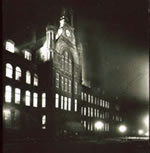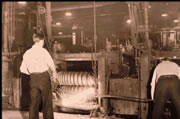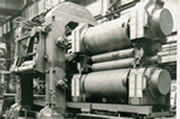Professor Emeritus Sir Hugh Ford
(City and Guilds)
from Boanerges to oblivion
This memory takes the form of a talk Professor Ford gave to the Mechanical Engineering Department as part of the Centenary celebrations in September 2007.
 I had heard about the City & Guilds College – not, you will note, Imperial College – from a lecturer at the Swindon Technical College. I was serving a 5 year Apprenticeship to Fitting, Turning and Erecting, in the Swindon Works of the Great Western Railway: God’s Wonderful Railway as it was rightly called.
I had heard about the City & Guilds College – not, you will note, Imperial College – from a lecturer at the Swindon Technical College. I was serving a 5 year Apprenticeship to Fitting, Turning and Erecting, in the Swindon Works of the Great Western Railway: God’s Wonderful Railway as it was rightly called.
Photo left: Hall Class Loco
THE REAL THING
By long hours of work and study in evening classes, and then from a day release scheme inaugurated by the GWR, I managed to enlist in the London University External Degree Course for an Inter-BSc year. I began to make some headway. I should explain that in those days of opportunity for boys from a poor background, one left school at 16 with Oxford Senior Locals or any other equivalent and what was called University Matriculation. My parents had squeezed their finances to pay for me to go as a ‘Day Bug’ to the Northampton Grammar School for three years, but that was the end of it and so, at 16, my life started in earnest.
But for those without money and lots of determination those were wonderful days of opportunity. Sir Joseph Whitworth had left a relatively large amount of money in his will for Whitworth Scholarships and the Ministry of Education ran competitive examinations for those whom Whitworth defined as time-served apprentices from poor backgrounds. I was lucky enough to win one – so City & Guilds it was.
Guildsmen in those days were largely of two sorts: those sons of their fathers who could afford to drink beer, play Rugger and do enough work to get a degree and so make their way upwards. The others were what were called “Brown-Baggers” – anxious types who carried their papers around in battered brown attaché cases and worked until the dawn was grey and ate their sandwiches on benches in the basement of the old Waterhouse Building. As a Great Western employee, I travelled on the railways and the Underground at ¼ fare so, living at home in Welwyn Garden City with my parents, made it possible to manage on the £150 per year Scholarship – fees were, I think, £50 per year. All the rest is inflation. Ponder that when our Scottish Overlords say they are doing a good job keeping inflation at 3% per year, and we are told that one is below subsistence level at £15,000 per year. Also, a bank note only says, “I promise to pay” and if it is 3 years old the promise to pay £20 has fallen down because it’s buying power is no more than £18.
 In 1934, the Guilds were in the original Waterhouse Building, with an entrance hall ruled by a former Sergeant Major called Coulson who wore a frock coat in City & Guilds colours and who gave all “freshers” a lecture on how to behave. Quite terrifying, but it ended up with an initiation in the form of a song. Photo right: The Waterhouse building
In 1934, the Guilds were in the original Waterhouse Building, with an entrance hall ruled by a former Sergeant Major called Coulson who wore a frock coat in City & Guilds colours and who gave all “freshers” a lecture on how to behave. Quite terrifying, but it ended up with an initiation in the form of a song. Photo right: The Waterhouse building
“Exercise, exercise, every morning when you rise
One leg up, one leg down, that’s the way to London Town.
Eat more fruit, eat more suet, eat more home-made pies.
Eat whatever you bloody well like, but you must have exercise”
It was followed by the President of the Union who made us learn the correct way to do a “Booma-lacka”.
Professor Unwin had just retired from the Headship of the Department and a Professor Lander had been brought in from the Government-supported Fuel Research Station and brought with him Dr Owen Saunders and Dr Margaret Fishenden, who brought with them the latest developments in fluid flow and heat transfer – that is the concept of non-dimensional groups. Lander had never lectured to a large group of students before and was highly nervous. In those days we had a lecture theatre attendant who saw that chalk was ready and wiped the board down when needed. Lander made mistakes and then suffered the ignominy of having the student body stamping on the floor (wood at that time). He always pretended that it was deliberate to see whether we were attending!
There were only two Professors; the HOD and a hard-hearted Professor Whittle who had started life as a mathematician, lectured on stress analysis and mathematics and ran the Accounts of the Department.
We took lectures from the Head of the Civil Engineering Department in “Structures”. Professor Pippard could not sound his ‘Rs’ so he talked about “Bwaced Fwame Stwuctures”. It was a broadly based course in those days, and no computers (thank God!), so basics were taught basically, not in mathematical methods to allow computer solutions to be made. There was a workshop instruction course (3 hours) as an introduction to workshop methods. Most students gained from this, having come direct from school, but when I protested I didn’t need to know how to use a lathe or a milling machine and could file a surface flat as well as anybody, I was told to shut up and get on with it, but very soon they gave me apparatus to mend or modify.
The Whitworth Scholarship was a compulsory three years, so having entered the Second year direct, I had a spare year to make up. (Peter Bayley verses). Owen Saunders had a research project from the British Iron and Steel Corporation for the study of heat transfer and fluid flow in Cowper Stoves. He set me the problem – to establish the appropriate non-dimensional groups and determine whether their behaviour could be used to scale down to allow meaningful experiments to be done in the laboratory.
Saunders was already a busy man on many outside projects as well as in Imperial College and, having set the task, left me largely to my own capabilities. When, after three years, the work turned out rather well and was published by the then Iron and Steel Institute, he liked it enough that it was published as “Saunders and Ford”, and he took the credit for it! (Hottel, at MIT). I got my PhD. The Lesson.
This brings me to July 1939. The War Clouds of the second German War burst. I was directed to Northwich in Cheshire to join the Brunner and Mond Division of ICI, to take the place of another Guildsman who was a Reserve RAF Fighter Pilot and had been immediately called up.
A dreamer chemist called Gibson had been given a project to investigate the manufacture of a possible polymeric compound by the high pressure route. ICI had been working for several years on the effect of very high pressures on chemical reactions. Everything they tried had led nowhere – nothing showed any advantage at 2000-2500 bars pressure over much lower pressures. As a final effort, Gibson was told to compress ethylene with another chemical whose name I have forgotten, to 2500 bars and 250 degrees centigrade. He (luckily) was unscientific enough to take a bottle of BOC ethylene (with a few impurities in it) and then forgot to put the second ingredient in. So, he compressed the ethylene sample in a small autoclave to 2500 bars and raised the temperature to 250 degrees centigrade and …..whoops!.....a terrific explosion (safety valves saved the autoclave) and Gibson woke up to the fact that he had forgotten the second component. When he opened the autoclave there was much carbon deposit but also some white powder. He had the honesty to admit his error and reported the white powder. He then did the right experiment with the two ingredients, but nothing happened. ICI were about to shut the programme down, Gibson was shunted to the Ethyl Corporation, and good chemists questioned what the white powder was. So good chemists repeated the experiment with pure ethylene and nothing happened. Gibson was ordered back to demonstrate what he had done. He admitted he had not used pure ethylene, but a bottle of BOC stuff from the stores. They got a bottle for him, he repeated the experiment and …..whoops!.....again, the white powder appeared! It was found that Gibson had made a long-chain polymer of ethylene because of a small trace of oxygen in the BOC sample. The first solid polymer of ethylene had been created.
In those days, ICI considered Chemical Engineers were bastards who were neither chemists nor engineers, so right from the beginning of any project they assigned an engineer (predominantly mechanical), to work with the chemists. Moreover, Brunner and Mond were against batch processes, so a small team of engineers were told to take the explosion and turn it into a continuous process!
Now, I come back to City and Guilds. The team consisted of one Cambridge man, WRD Manning, plus four chaps from City and Guilds. Two, who had been lecturers in Mechanical Engineering, Clifford Hunter and Edward Greensmith and one (the Pilot Officer) called Bates who had been a student and then myself who took the airman’s place, plus being the assistant during construction under Clifford Hunter, together with responsibility for the Research Workshops where all the critical small components were made.
The importance of polythene was that it had a very high dielectric constant, ideal for the radar equipments vital to the war effort.
None of the Engineers ever got the credit they deserved for making a continuous process plant to work at such a high pressure to control an explosion so that the valuable white powder came out at the finishing end, not a mess of carbon deposits. The Americans, the Germans and the Dutch all tried – and failed.
An interesting side-comment. Present day Health and Safety nonsense would not have allowed such a process to be set up. The Brunner and Mond Directors merely said to us, “Safety is your responsibility”.
There are so many stories I could tell of the new ground we had to cover in the development of polyethylene plants, but I must pass on to many other things. One thing is worth emphasising because it ran through so many aspects of my later life. These were the days long before Business Schools had lectured Industry on “down-sizing and outsourcing”, and even Divisions of large companies had sophisticated staff and laboratories involved in forward thinking and developing. It was possible for Brunner and Mond Division of ICI to have their own extensive Research & Development Departments, uncontrolled by a Central Finance hierarchy to stop them taking shots in the dark.
This brings me to 1942. I married a Cheshire Girl, whose father’s estate had been forcibly taken over by ICI for housing. She did not like ICI so, after the immediate problems of Polythene manufacture had been overcome, I looked for pastures new under her urgent appeals.
I saw an advertisement for somebody to head-up the Metal Working Division of the Steel Industries research organisation. This meant a headquarters in Tothill Street and research laboratories in Sheffield University. The main projects were : setting up facilities and then a research programme to investigate the behaviour of continuous strand cold rolling mills and the changeover of the Welsh five-part tin-plate rolling and dip-tinning of thin steel to the continuous electro-tinning process now general in the USA. The head of the British Iron and Steel Corporation and Federation was Sir William Larke. When he interviewed me he expressed disappointment that I wasn’t a Cambridge man, nor had I grown up in the Steel Industry, but at least I had been at Swindon, and good candidates were unavailable, so I got the job.
This meant moving to London and Sheffield. My wife considered the only London address was Chelsea, so we got a flat in Tite Street – easy in those days with bombs falling – and a boarding house room in Sheffield, where I spent most of the first two years.
 I set up a small single stand mill with electrically driven front and back coilers which could act strictly as coilers, but also could simulate the effect of other mill stands of a multi-stand mill. The set-up had sophisticated control gear between the coilers and the mill stand and, with the aid of a brilliant instrument specialist, we instrumented the whole mill using the newly-invented resistance strain gauges to measure roll force and torque on all three elements of the mill. I had to recruit the whole team – no easy task in those war years, but the work was considered vital to the war effort since single-stand hand mills were virtually rendered obsolete by the high speed continuous hot and cold strip mills coming from the States. But the Americans measured strip thickness about two meters after the final stand and before the coiler on strip moving at 60mph or more, by a thing called a “flying mike”. This was useless as a means of controlling strip gauge and my job was to investigate the process to provide better control and uniformity of strip gauge.
I set up a small single stand mill with electrically driven front and back coilers which could act strictly as coilers, but also could simulate the effect of other mill stands of a multi-stand mill. The set-up had sophisticated control gear between the coilers and the mill stand and, with the aid of a brilliant instrument specialist, we instrumented the whole mill using the newly-invented resistance strain gauges to measure roll force and torque on all three elements of the mill. I had to recruit the whole team – no easy task in those war years, but the work was considered vital to the war effort since single-stand hand mills were virtually rendered obsolete by the high speed continuous hot and cold strip mills coming from the States. But the Americans measured strip thickness about two meters after the final stand and before the coiler on strip moving at 60mph or more, by a thing called a “flying mike”. This was useless as a means of controlling strip gauge and my job was to investigate the process to provide better control and uniformity of strip gauge.
That work led to the world-patent on automatic gauge control, using the readings of the roll force meters under the screw-down gear to make virtually instantaneous correction, either by controlling strip tension or modulation of the screw-down gear settings. That invention put us ahead of everybody and led to much inflow of wealth to Britain. (The patent was sold to Davy-Ashmore, the mill builders of whom more later).
 Teaching Welsh tinplate rollers that the batch, five-part process had to go in favour of continuous strip rolling and electro-tinning was no easy task. I was instrumental in setting up Sketty Hall near Swansea, to act as a research organisation so that the Welsh could undertake their own conversion, but it was not easy. The British Iron and Steel Research Association had, by that time, been set up with Sir Charles Goodeve as Director. He told me that the staff must be at least 20% English, not all Welshmen! A mere Englishman myself had little possibility of achieving that and it ended up as a Welsh operation entirely!
Teaching Welsh tinplate rollers that the batch, five-part process had to go in favour of continuous strip rolling and electro-tinning was no easy task. I was instrumental in setting up Sketty Hall near Swansea, to act as a research organisation so that the Welsh could undertake their own conversion, but it was not easy. The British Iron and Steel Research Association had, by that time, been set up with Sir Charles Goodeve as Director. He told me that the staff must be at least 20% English, not all Welshmen! A mere Englishman myself had little possibility of achieving that and it ended up as a Welsh operation entirely!
Photo right: Part of Professor Sir Hugh Ford's work in Sheffield.
So we came to 1945 and the War ended. The main work in Sheffield had been developed into a major activity that outgrew our laboratories in Sheffield University and my job brought me more to London. I was pressured into joining a company called Paterson Engineering, who designed and made water treatment works; as Director of Engineering, I got my first experience of Board Meetings and commercial people. I could tell you quite a lot about how not to run a company and I was not very happy there. One day, in the middle of a Board Meeting, there was an urgent telephone call for me. Professor Saunders was on the line and reminded me that, at my PhD Oral, I had said that one day I would like to return to City & Guilds and did I still feel that way. I said, “The answer’s yes, but I can’t stop now.”
So, once again, I was at Guilds. In those days, Professorships were rare, not like today when they are two-a-penny, so I was made Reader in Applied Mechanics at a lower salary than I had enjoyed in industry! But there was always consulting work and as long as one did one’s job at College to the full, it was open to anybody to undertake consulting. So, I joined my former boss at British Iron and Steel, who, after retirement from BISF, had started a consulting practice. He told me there were only two rules in consulting: never accept any engagement, however lucrative, in which you are not competent; and never be cheap because people won’t have confidence in you.
Good advice! I was about the only Engineer who left ICI who knew the high pressure polyethylene process from the inside, and I was in great demand because ICI had started licensing the process everywhere. I had clients from Japan to Los Angeles. It had great value for research contracts in the Mechanical Engineering Department at College – real engineering studies for Post Graduates and techniques in stress analysis for undergraduate courses. But also, there was metal working research and there are many Professors, dead and alive, who are sprinkled around the globe, including a Turkish Government Minister, the Greek Minister who was in charge of their Olympic arrangements, and leaders of Industry, here and abroad.
 Through it all ran the theme of Boanerges, and one of my great moments was that when, having acted as President of the Motor Club for many years, the Club presented to me on the half century of Bo’s service, this delightful and most accurate silver model of our James and Brown. It took three silversmiths to achieve it: the first died on the job, the second gave up because he found it too difficult, and the third became so fascinated with the project that the Club had the greatest difficulty in getting him to surrender it in time for presentation to me at Brighton! I have decided that when I pass on, it shall be left to the City & Guilds Motor Club though, I suggest, for safety reasons, it should be housed elsewhere. Mind you, don’t expect it too soon – there are a few years in me yet! Photo left: Siver model of the James and Brown motor.
Through it all ran the theme of Boanerges, and one of my great moments was that when, having acted as President of the Motor Club for many years, the Club presented to me on the half century of Bo’s service, this delightful and most accurate silver model of our James and Brown. It took three silversmiths to achieve it: the first died on the job, the second gave up because he found it too difficult, and the third became so fascinated with the project that the Club had the greatest difficulty in getting him to surrender it in time for presentation to me at Brighton! I have decided that when I pass on, it shall be left to the City & Guilds Motor Club though, I suggest, for safety reasons, it should be housed elsewhere. Mind you, don’t expect it too soon – there are a few years in me yet! Photo left: Siver model of the James and Brown motor.
In all this I must pay tribute to Dr Shaun Crofton, who has given so much more over a much longer time that I have – and still does.
From the Fifties onwards, the rebuilding of the Mechanical Engineering Department went on for many years. Unlike most other departments, we had to build the new Department on the site of the old one and we had laboratories and people scattered in Transit Camps, as well as suffering noise and inconvenience of one part of the new building being constructed while an adjacent part was still occupied. I want to say how much I valued the patience and cheerfulness with which all this pandemonium was accepted by all my colleagues. And students were just as good.
At that time we occupied the whole of the Exhibition Road frontage from Imperial College Road to the Mines and Metallurgy Building. Although many changes have occurred since my time and the Department has given over space to other things, it has never lost its premier position in the assessment of the Country’s Mechanical Engineering Departments. I am delighted to learn that it is to be refurbished and re-equipped over the next few years. I would like to take this opportunity to congratulate Professor Kinloch on his appointment as our new HOD and wish him success in all his endeavours. We are unique in having four FRS’s in the Department at the same time, as well as many who have gone before.
Now I would like to turn to the wider scene and consider where Mechanical Engineering fits into the future of the world. I see it as still very much at the centre of our existence in the years to come and I can only hope Imperial College will recognise the vital part it has to play if humanity is to survive in any civilised form.
There is an increasing concern about what is called Global Warming and the use of energy, particularly in the form of electrical energy, which has such importance in industry, in public life and in the home and the way we live.
It seems to me that Governments and their Advisors are trying to address the effects, not the cause. To me, the cause is God Almighty. I refer, of course, to the God Almighty Dollar that holds power and sway over us all.
Let me go back in history a little. When Great Britain had some right to that title, we made lasting products that were exported all over the world, yet we were a frugal economy – nothing was wasted. But two devastating wars changed all that. Also, a chap called H Ford had, in the early years of the Twentieth Century, set up the first major mass production factory. At the time, it was a splendid thing because the USA was very large and TIN LIZZIES, as his early cars were called, were urgently needed. But then this took over and today most things, not just cars – washing machines, refrigerators, dish-washers – are all made in mass production factories.
Now there is an inevitable consequence of this. When you have satisfied the immediate markets for the products, there is only one way out. Things must be designed and made with built-in obsolescence, because all the materials and energy fed into a mass production system, has, sooner or later, to be destroyed at the other end. If it isn’t, there is a build-up of unwanted products and the factory has to stop. This is anathema to everything that our Effluent Society believes in, so clever people in the advertising world think up ways to make the public think they must have something NEW! If you are wise enough (or, of course to Almighty Dollar religion, foolish enough), to make lasting products that can be maintained and improved, you go out of business certainly. Now-a-days, when design obsolescence decrees that things must be made for a life of ten, or more likely, five years, and as a consequence often last for even less. Energy – and the materials that depend upon it – are being used up at a world-destructive rate.
I can give you many examples:
1. A fridge-freezer that lasted for less than 10 years and could not be made to work – so throw it away – to be replaced by another “top of the range” product that lasted for less than 6 months, when again – throw it away.
2. A British made compact-dishwasher, however, lasted so long that I have forgotten when I bought it. Finally, some small part of the electrics failed, but the Company had foolishly made lasting products so they had gone out of business; there were no replacement parts and no technician knew how to deal with it, so throw it away.
3. The replacement, sizeably bigger for the same capability, lasted less than two years and caught on fire – luckily I was there and saved the house from going up in flames. Throw it away!
4. The first car I ever owned was a second-hand 4/50 Wolseley. A stupid retired Judge came out of a side road at speed and ran into the near side of our car, turning us over twice. Luckily the Wolseley landed back on its wheels and my wife and I got out, battered but alive because the roof did not cave in, and eventually the car was repaired, renovated and I continued to use it safely for a number of years. It was sold, not because it had worn out, but because I had a bigger family and we needed something more commodious. But all three cars were only partially mass produced, all three were second hand and I still have the last one (44 years old).
So, let us sum this up. Since God Almighty Dollar and Disciple Effluent Society is gaining more recruits at a terrifying rate: a new Archbishopric has arisen in China and this is being unwillingly but inevitably followed by India: so energy, and its close companion materials, are being used up and spread in a thin irrecoverable layer all over the earth’s surface. Since nobody has the courage to challenge this wrongly conceived system, all efforts are put into trying to save energy and materials, not by making them serviceable for a much longer time, but by Recycling! What a farce! Recycling needs so much energy to reach a mediocre recovery of some of our products. (The Pilkington assessment of bottle recycling).
Let me return to those early days of the production of polythene to illustrate the strength of my argument. When the vital need of a high dielectric material fell off after 1945, the other possible applications of polyethylene had to be found. Now every morning of my life I experience the devastating flow of polythene film wrapped around junk mail that I never asked for, and don’t want. Just think of that happening in all parts of the Globe – all waste energy and materials to be thrown away! Each year, and every year!
Twenty years ago, I saw the devastating consequence of the throw-away society and gave a lecture at an International Conference in Singapore on “Energy and Economics in a Consumer Society”. I put forward the concept of Total Energy Life Cycle.
Energy is a universal measure of every artefact we produce and use. This energy is made up of :-
a) The energy in winning minerals and other deposits from the ground
b) The energy to separate these materials from the overburden
c) The energy to reduce or modify minerals to pure metals (e.g., iron, copper, aluminium, rock salt, oil and gas)
d) The energy needed to transport the results to the point of use and subsequent manufacture
e) The energy to form, machine, or otherwise shape them to the final components
f) The energy to assemble the components into the complete machine or appliance
g) The energy to transport the appliance to its final destination
h) The energy to maintain it during its working life
i) The energy to get rid of it at the end of its conceived useful life
The Total Energy Life Cycle concept applies to a blast furnace, a power station or a bicycle or a refrigerator, with equal relevance.
To sum up.
1. Most of the equipment of modern day life has a large component of Mechanical Engineering in it.
2. If we have any sense of responsibility for our children’s children’s children, we must grasp our overwhelming responsibility for conserving energy sources for them, because if we continue with the present Effluent Economy and Society there will be no energy sources left to them, especially with World population increasing to 10 billion within the next two or three decades.
3. Mechanical Engineers need to start thinking NOW about designing for long, maintainable, developable manufacture, and turn their backs on the Effluent Society.
4.
We can start this tomorrow in small subtle ways in the things we design and make.
And so to oblivion.
Thank you for listening to me.
© 2007 Imperial College London

Through the first decade of the twenty-first century the campaign seeks to philanthropically raise £207 million from Imperial’s alumni, staff and friends, and donations from charitable foundations and industry.
Where your support can make a differenceGive now

Imperial’s Centenary Year provides an opportunity to recognise and celebrate members of the Imperial community.
View staff and student portraits
